On the sign:
ΠΛΑΤΕΊΑ ΑΓΊΑΣ ΑΙΚΑΤΕΡΊΝΗΣ ΕΛΛΗΝΡΣΟΥΗΔΙΚΉ ΑΝΑΣΚΑΦΉ
HAGHIA AIKATERINI SQUARE GREEK-SWEDISH EXCAVATIONS
Η ελληνρσουηδική ανασκαφή στην Πλατεία Αγίας Αικατερίνης στο λόφο Καστέλλι καλύπτει 5000 χρόνα ιστορίας Της πόλης των Χανίων-από τη μεταβατική
Νεολίθική περίοδο (περίπου 3000 π.Χ.) μέχρι 1ς μέρες μας Το μεγαλύτερο μέρος από τα ορατά λείψανα της ανασκαφής ανήκει σε Τμήμα της εγκατάστασης που καταστράφηκε από μεγάλη πυρκαγιά νύρωστο 1450 π.Χ. (Υστερομινωική IB φάση) . Τα κτίρια (με καστανό χρμα στο σχέδιο ) σχημάτιζαν κοικοδομικά πετράγωναη με στενούς δρόμους και πλατείες Ένα από αυτά, η ΟΙΚΙΑ Ι, επιφανείας 225 τ.μ. έχει πλήρως ανασκαφεί. Από το δρόμο μπορούσε κανείς να εισέλθει στον προθάλαμο (H) που οδηνούσε στο κυρίως δωμάτιο Τη κμινωική αίθουσα (A+C).
Ο προθάλαμος οδηγούσε επίσης σε δεύερο μικρά δωμάτο () από όπου ανέβαινε κανες με κλίμακα στον πρτο όροφο ή προχωρούσε μέσω Του δωματίου Ν σε εναίο χρο μαγειρείου και εργασίας (M). όπου αποκαλύφθηκαν τα απομεινάρια αργαλειου Το δωμάτιο Ε ήταν η αποθήκη της οικίας-ένα από τα αγγεία που υπήρχαν σε αυτό περιείχε Τρία κιλα καμένο λαθούρι και φακές Εδ βρέθηκαν επίσης δύο πιναίδες της μνωικής Γραμμικής Α γραφής ποαχαν πέσει από τον επάνω όροφο . Το δωμάτιοι D περιείχε πολλά διακοσμημένα πήλινα αγγεία και άλλα λίθινα, σφραγίδες , περίαπτα και κόσμήματα Το κτίριο αυτό περιείχε συνολικά 300 ολόκληρα αγγεία, μερικά από τα οποία έκrίθενται στο ΑρχαιολογΚΟ Μουσείο Χανίων
Μετά την καταστροψή o άνθprοετέστρεψαν και κατοίκησαν στα χαλάσματα (τα δωμάτια Α 1 και ο της Οικίας | ξαναχρησιμοποιήθηκαν ) Νέα κτίρια ( με πράσινο χρμα στο σχέδιο ) δε χτίστηκαν παρά μόνο κατά την ΥΜΑ περίοδο περίπου 1850 π.Χ. ) , για να καταστραφούν ξανά από φωτά περίπου 100 χρόνια αργότερα, Από αυτή την καταστροφή της ΥΜ 11B1 φάσης προέκυψε το καταπληκτικό εύρημα των πνακίδων της ηραμμικής Β. δηλαδη της γραφής της πρωμότερης μορφής της ελληνικής γλσσας την σποία μιλούσυν οι Μυκηναίοι Της ηπειρωτικής Ελλάδας Ακόμα , σε αυτή και την επόμενη περίοδο ΜΜ ΠΙΑ και 1ΙB) άνθησε το περίφημο τοπικό εργαστήριο κεραμικής (κεργαστήριο Κυδωνίας-) , πολλά αγγεία του οποίου βρέθηκαν στα δωμάτια a και c ε Οι οικισμός ξαναχτίστηκε και η κατοίκηση συνεχίστηκε ως και τον 12 αι . π.Χ. (ΥM lr περίοδος) . Ξανακατοικήθηκε πλέον κατά την Υστερη Γεωμετρική περίοδο (β μσό8 aι. π.Χ. ) και δεν εγκαταλείφθηκε έκτοτε, Τα εντυπωσιακότερα απομεινάρια Των νεότερων στρωμάτων είναι οι βαθιά θεμελιωμένο τοo των ενετικν και τούρκικων κτρίων ( με κίτρινο χρμα στο σχέδιο) Για να κατασκευασιούν τα κτίρια της ΥΜ ΙB φάσης ( με καστανό χρμα στο σχέδιο ) , Το μεγαυερο Τμήμα της προγενέστπερης εγκατάστασης κατεδαφίστηκε στε να χτιστεί σωστά ο προσχεδιασμένος οιοσμός Κάτω σπό is νέα αυτa κτρια σζονται τα ερείπια μιας ιδιαίτερα επιμελημένης εγκατάστασης ης Πρωτομινωικής περιόδου Στα εντυπωσιακότερα ευρήματα συγκαταλέγονται έναελεφοντοστένο πλακίδο ίσως Τμήμα από επτραπέζο παιχνίδι Στον κενό από κτίρια της ΥΜΙ περιόδου χδpo αποκαλύφθηκαν επίσης μεσομινωκά λείψανα με κωοκέλυφα , pεταξύ άλλων , πήλινα σκεύη .
The Greek-Swedish Excavations in Haghia Aikaterini Square, Kastelli Hill cover 5000 years of history of the settlement at Khania - from the Transitional Neolithic period (c. 3000 B.C.) till the present day.
Most of what to-day can be seen at the excavation site belongs to a part of the settlement which was destroyed in a big conflagration c. 1450 B.C. (Late Minoan IB). The houses(brown colour on the plan) were built in blocks and divided by narrow streets and squares. One building, HOUSE I, measuring 225 m² has been completely excavated. From the street one entered the entrance hall (H) which gave access to the main room, the Minoan Hall (A+C). From the entrance hall one could also go to a small lobby (0) from where a staircase let to the 1st floor or one might continue through N into a combined kitchen and work room (M), where remains of a loom was discovered. E was the store room of the house and one of the vases found here contained 3 kgs of burnt peas. In the same room two Linear A tablets with the Minoan script were found, fallen from the room above. D was probably the treasury. Here were found many decorated clay vessels, stone vases, sealings, seals, amulets and jewellery. All together the house contained more than 300 complete vases, some of which are on exhibition in the Archaeological Museum
After the destruction the people returned and settled in the ruins (rooms A, I, and Q were reused in House I). Only in Late Minoan IIIA (c. 1350 B.C.) new houses were erected on the site (green colour on the plan). These houses were destroyed in a fire ca. 100 years later and from this destruction in Late Minoan IIIB:1 came the sensational finds of Linear B tablets written in the earliest known Greek of the Mycenaeans from the mainland. It is also in this and the following period (Late Minoan IIIA and IIIB) that the famous local pottery workshop flourishes, many vases of which were found in rooms a and c.
The settlement was rebuilt and habitation continued into the 12th century B.C. (Late Minoan IIIC: light blue colour on the plan). In the Late Geometric period (late 8th c. B.C.) people returned to the site, which has been inhabited since then (light green colour on the plan). The most impressive remains from the Post-Minoan levels are the deep wall foundations of the Venetian and Turkish buildings (yellow colour on the plan).
When the Late Minoan I B houses (brown colour) were constructed most of the previous settlement was demolished in order to built the pre-planned settlement correctly. Below these houses there are the remains of a very well constructed settlement of the Early Minoan period (3rd millennium: dark blue colour on the plan). One of the most spectacular finds is an ivory plaque - perhaps a piece of a gaming board. In the area without Late Minoan I buildings was also discovered remains from the Middle Minoan period (dark green colour on the plan) with, among others, finds of eggshell ware.

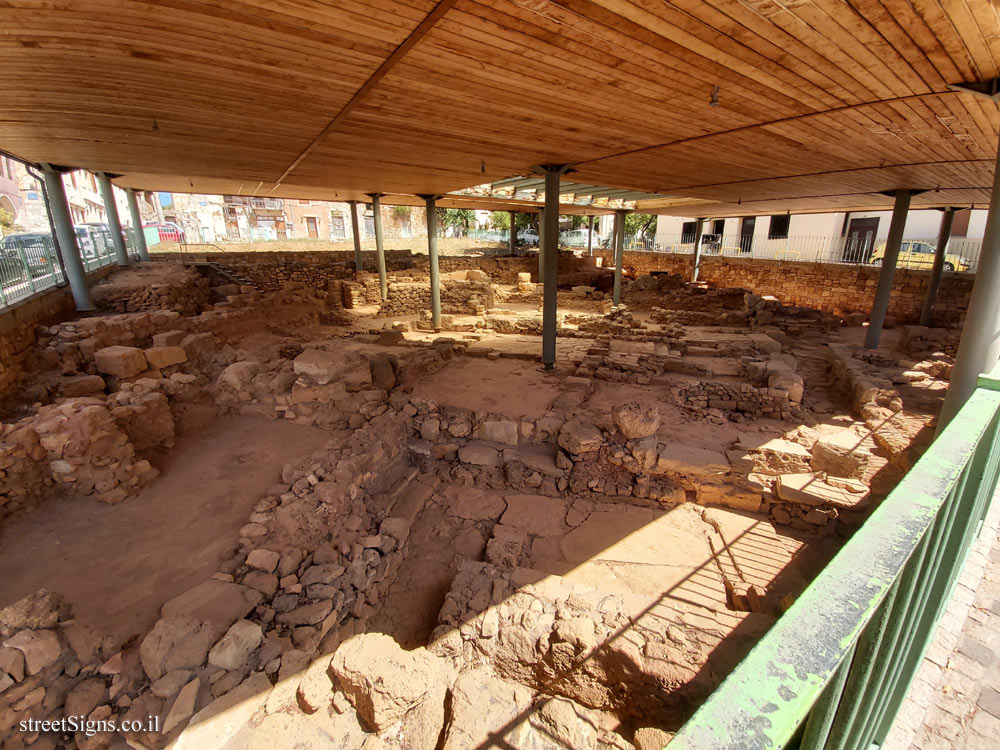 Click for a larger image
Click for a larger image 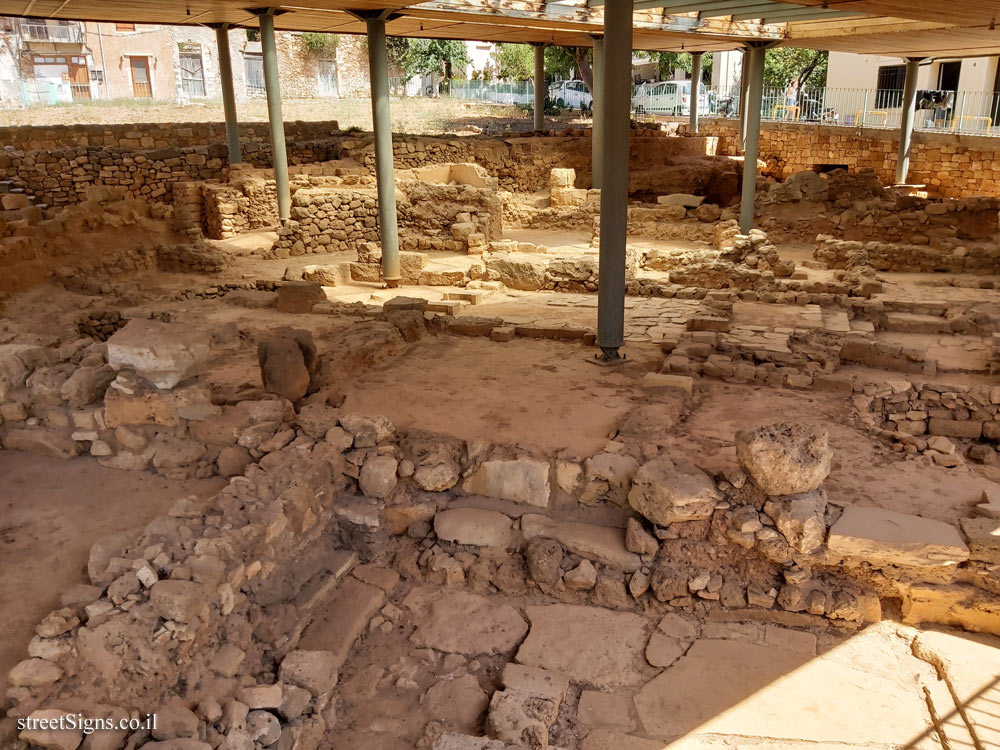 Click for a larger image
Click for a larger image 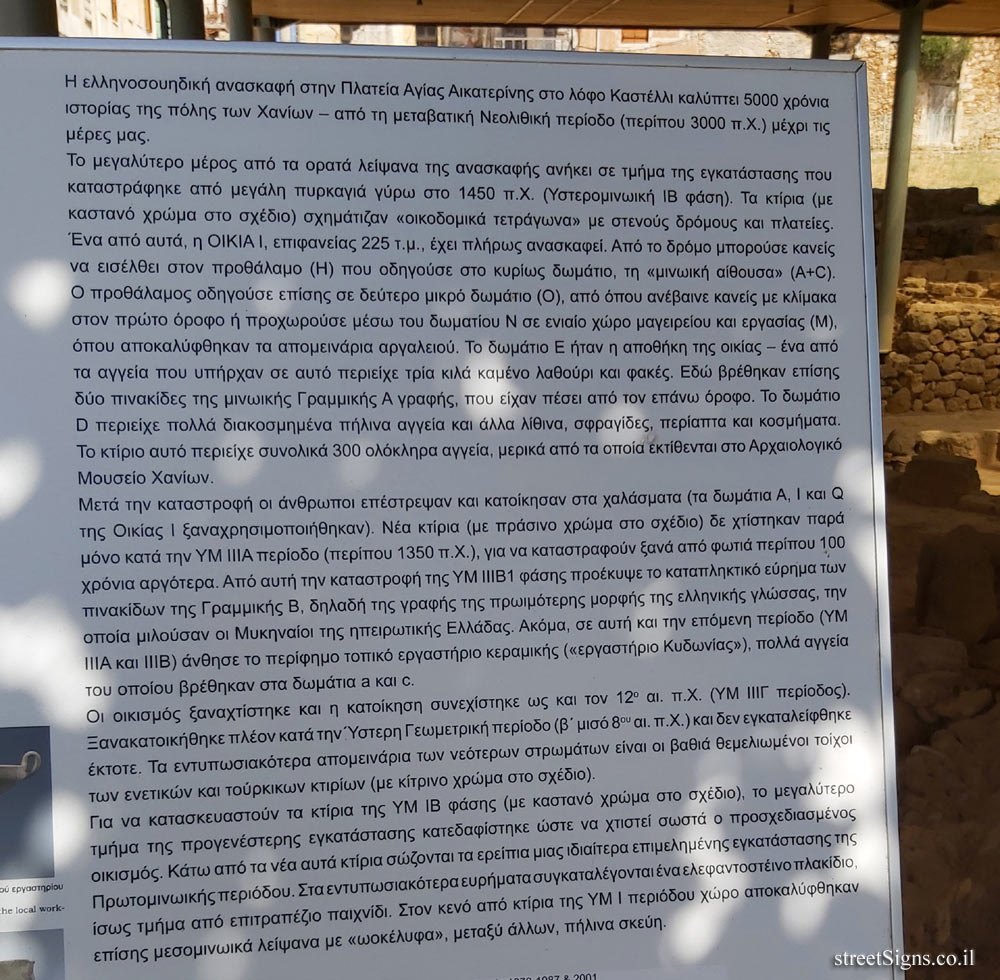 Click for a larger image
Click for a larger image 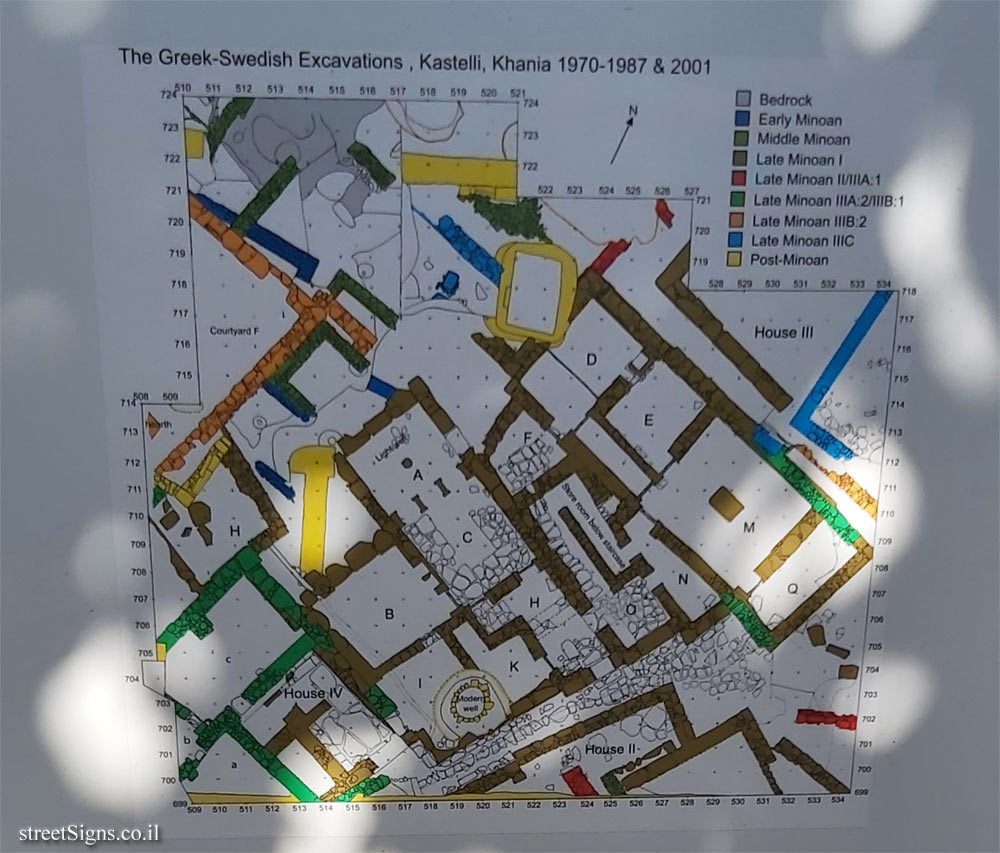 Click for a larger image
Click for a larger image 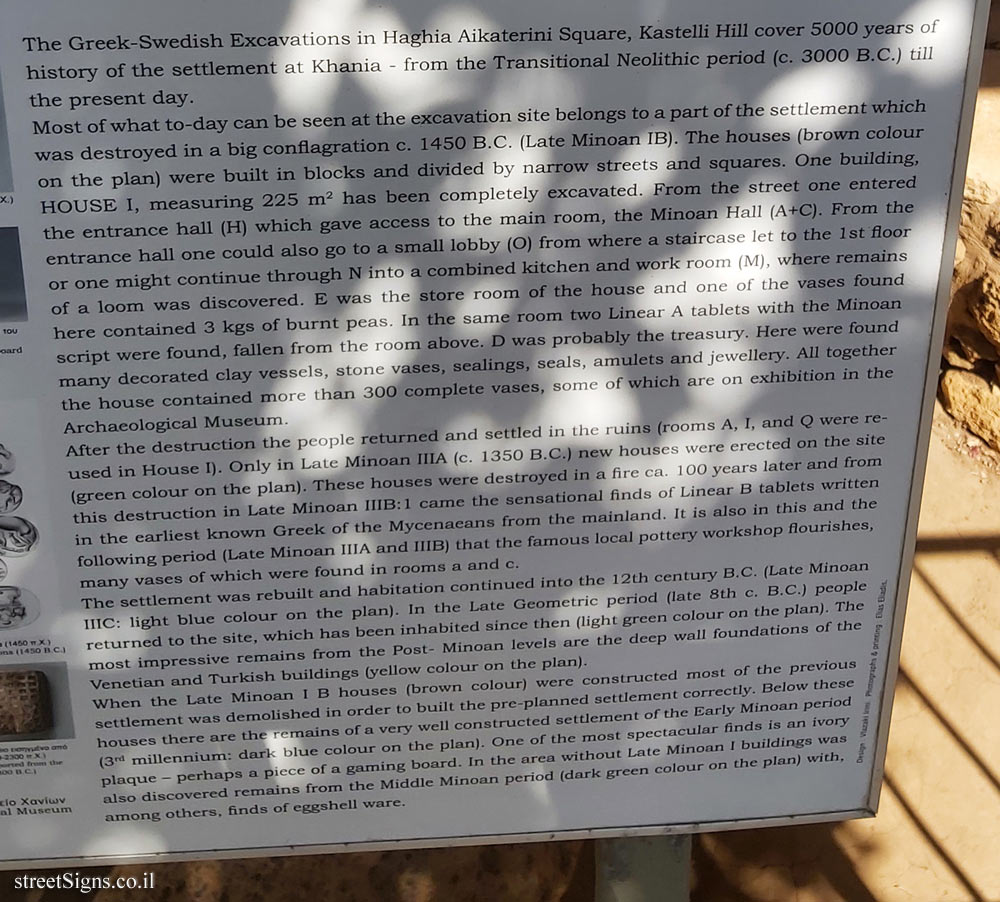 Click for a larger image
Click for a larger image 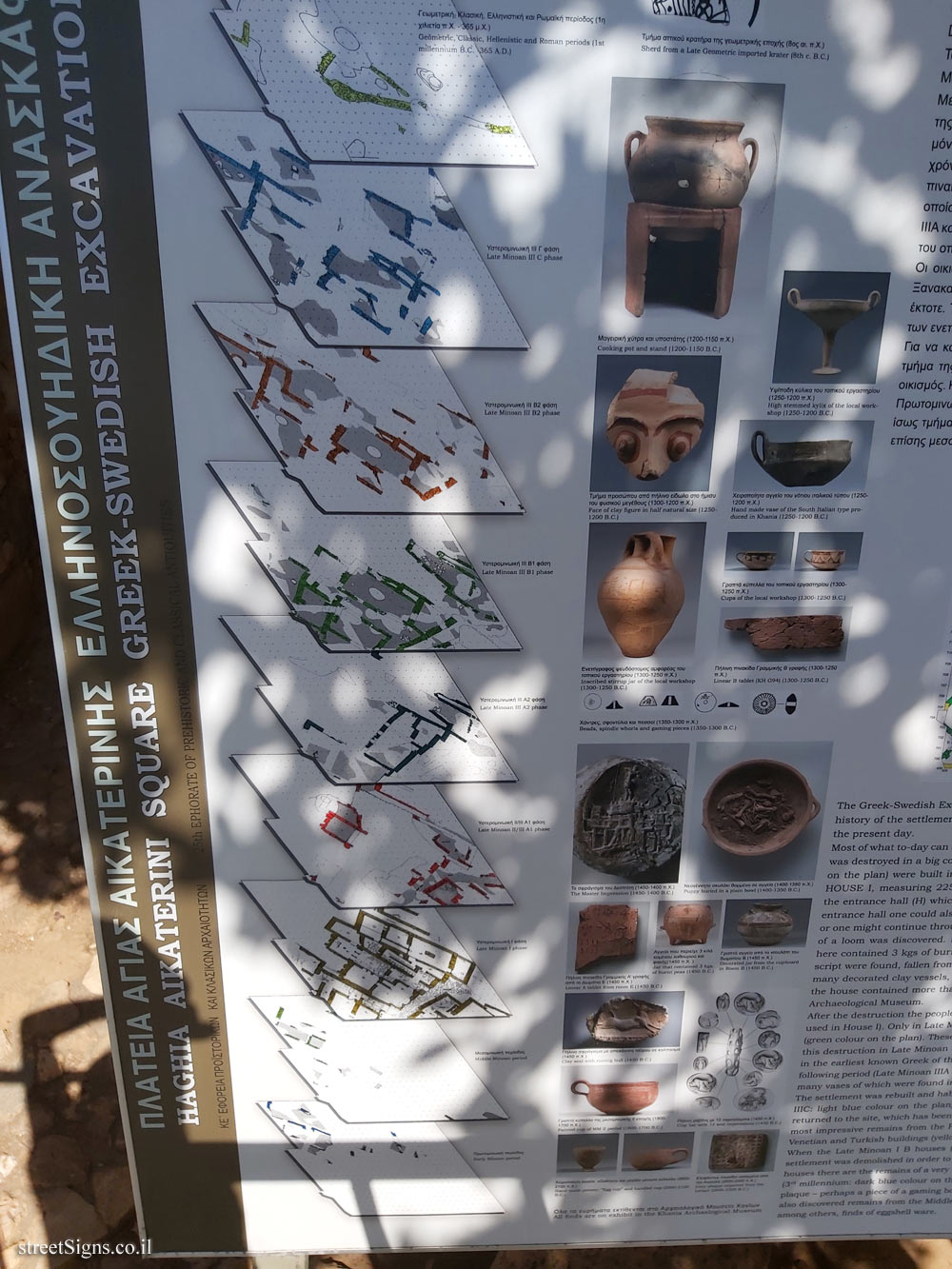 Click for a larger image
Click for a larger image